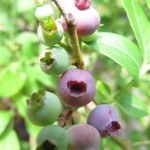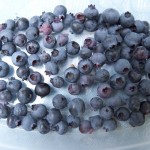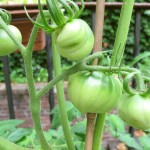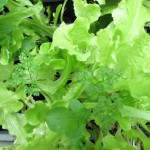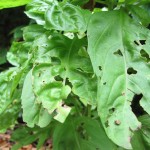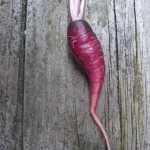Click here to see the most insanely cute photos of 5 Eastern Screech Owls that were just released in Central Park.
Author Archives: admin
From school yards to school gardens
BYELIZABETH LAZAROWITZ
Tuesday, July 14th 2009, 9:39 AM
It’s a rural lesson in an urban jungle.
Students at 10 Brooklyn schools will be toiling in the soil this summer and fall, growing vegetables to feed their classmates as part of an effort to get student-grown foods into the school cafeteria.
“We want to eat the stuff we grow,” said Aidan Israel, 7, a student at Public School 107 on Eighth Ave. in Park Slope, who has been helping cultivate peas, kale and basil in the school’s yard. “It tastes fresher than the stuff in the store.”
With its fall harvest, PS 107 – which is in mobile “earth boxes” while its new garden is closed due to a school renovation – will join a program started last autumn by the Department of Education’s SchoolFood department and the state’s Department of Agriculture and Markets.
Dubbed “Garden to School Cafe,” it began with 20 schools citywide – nearly half of them in Brooklyn.
Next year, the program, which lets school cafeteria staffers put kid-gardened produce on the menu, will expand to about 25 schools as part of a broader effort to source school food locally, said Billy Doherty, who heads the program for SchoolFood.
“It’s something that’s important in terms of teaching the kids how to eat better and connecting them to farming, to help them have an overall healthy lifestyle,” Doherty said.
Last week, PS 29 science teacher Tina Reres and a group of incoming prekindergarten students gathered around one of four long gardening beds built behind the Cobble Hill school. They tied up tomato plants, searched for bugs and then lettuce shoots that, if all goes well, will be part of a meal the school’s students will get to eat in the fall.
“It’s a chance to learn where your food comes from,” said Kristin Berman as her daughter Julia, 3, dug in the soil. “City kids don’t really know that.”
Some of the schools – like the Urban Assembly School of Music and Art in DUMBO – are combining food-growing with culinary lessons. Students in the school’s Teen Iron Chef program grew parsley and mint for tabbouleh and demonstrated how to make it, said Lynn Fredricks of FamilyCook Productions, who runs the cooking program. “For them to actually create the food itself is pretty amazing.”
Pesto pasta from school-grown basil was a big hit with kids at PS 29 last fall, Reres said.
But whether getting locally grown foods will really get kids to eat more veggies remains to be seen.
Mia Espinosa, 4, turned up her nose at the peas she had excitedly plucked from the PS 29 garden.
“She won’t eat anything green,” her grandmother, Carmela Panico, said, sighing. “Maybe next year.”
Fighting Chicken Mites
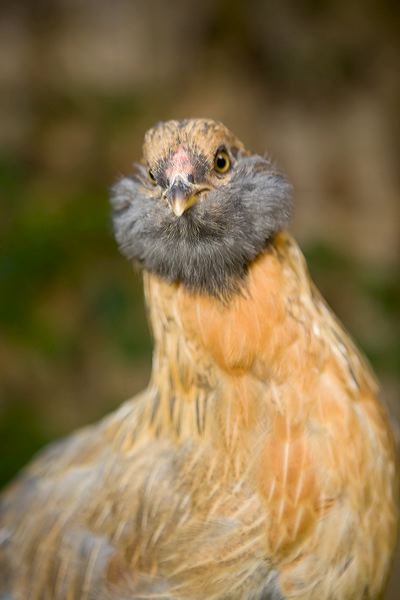
Edie with her beard
I’ve been so ashamed to admit that my pampered, pet chickens have mites that until recently I haven’t told a sole. I’ve spent many, many late night hours searching through the archives of backyardchicken.com educating myself on how to spot them and how to get rid of them. There are many different schools of thought, which, although helpful, has added to my confusion on how to deal with the problem.
My battle started a few months ago when I noticed Edie’s luxurious beard getting a little mangy looking. I bought a bag of diatomaceous earth and sprinkled it liberally inside their coop. Diatomaceous earth or DE for short, is fossilized diatoms or a hard-shelled algae. It’s tiny edges abrade soft-bodied animals that come into contact with it causing them to die of dehydration. You use food-grade DE with chickens (non-food-grade is lethal) to kill mites, lice and to deter flies. Some gardeners also sprinkle the stuff around their plants to protect them from slugs. When using DE, you must wear a dust mask and eye protection.
I also read that you need to dust your chickens. What the heck does a city girl know about how to dust a chicken?! I immediately turned to the internet, which has never let me down until this point. I was told to hold them upside down by their legs and sprinkle the DE all over them. Under wings, by their vent (chicken speak for poop shoot) and around their neck. You can put the DE in the foot of a stocking and use it like a powder puff. I thought for sure that YouTube would have a video showing me how to do that, but they didn’t. They have lots of videos of chickens rolling around in the dirt taking a voluntary dust bath in case you are interested in that? No? Okay. I also read that you can put DE in a plastic bag, put the chicken into the bag up to its neck and then just shake the bag. One person on the chicken forum made the connection to Shake N’ Bake and I can’t get that image out of my mind now. Plus I can’t figure out how to do that without strangling your chicken.
We then proceeded to have the rainiest June I can remember. Every time I dusted the chickens (which consisted of me sprinkling DE on them and then trying to massage it under their feathers) and their run it would rain. DE doesn’t work when it gets wet. Gah. Edie started to look mangier and her egg production fell off. When she layed eggs, they were strange – bumps on the shells, soft-shells, no shells. She didn’t act sick, but I knew that there was a problem. I bought some Poultry Protector and sprayed it in their coop and on them. Poultry Protector is a natural enzyme that kills mites, but isn’t harmful to the birds or the environment.
But the rain continued and I didn’t get rid of the mites. Or at least Edie’s neck and eggs still were in bad shape. Getting rid of mites is a bit like fighting an invisible boogey man. I could never see them, but I knew they were there. I decided to use different products. I stepped up a rung on the toxic spray ladder and bought some permethrin. I draw the line at Sevin, which a lot of people use to great success. What killed the Sevin for me was the part on the warning label that says it kills bees. I couldn’t be a part of the collapse of the honey bee population. Permethrin is derived from plants, which makes it sound less toxic, although it too has a pretty long list of warnings on the bottle. I sprayed the coop after I cleaned it thoroughly and I also sprayed the wood chips in the run. I also sprayed a little on the girl’s tushes. I washed Edie’s tush because it was getting a little dirty looking. I was horrified to see lots of missing and broken feathers. See thoroughly gross photo…
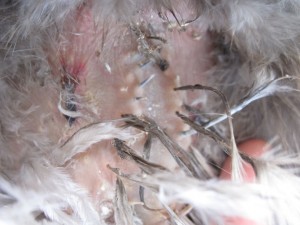
broken and missing vent feathers
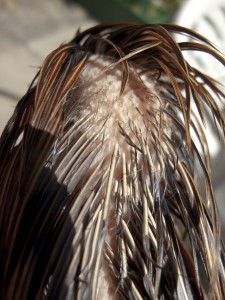
feathers missing on the back of Edie’s neck
I also bought flea and tick shampoo and powder. My toxic arsenal was getting larger!! They both contain permethrin in their ingredient lists. A lot of chicken keepers have success bathing their chickens in flea shampoo, so I thought I would give that a try. You see, you have to continue battling the chicken mites for a while to break their egg cycle. These products kill the mites, but not the eggs, so you have to do a second or third (or in my case 45th) round to make sure you catch all the hatching mites. The discouraging part is that even though you might kill all the mites in your immediate coop area, some mites can live for 6 weeks off their host and can come back to re-infest your flock.
So here are some photos of Edie after her flea bath. I put her in my daughter’s Lego tub and then lathered her up on the patio. I rinsed her several times with warm water to get the shampoo off of her. You have to make sure when doing this that your bird doesn’t get chilled. Even though it was a very warm and sunny day, I could feel her shivering a bit. I toweled her off and held her in the sunshine until she was dry. As you can see, she was not happy at all about being shampooed.
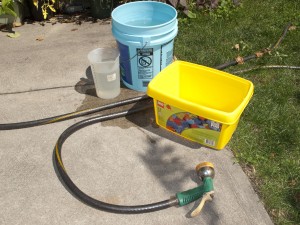
chicken washing station
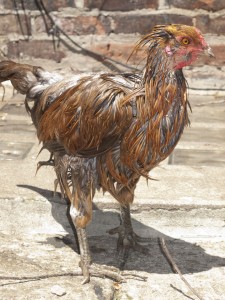
an angry wet hen
I also just ordered plastic roosting posts from Omlet as I read that mites can hide in the tiny cracks in wooden posts. When those arrive I will do another entire breakdown, scrubbing and dusting of their coop and run. Edie’s neck still looks very mangy, but I think I see some feathers growing in. I’ve been feeding all the girls yogurt (probiotics) and cat food (protein to help re-grow feathers), which they devour with gusto.
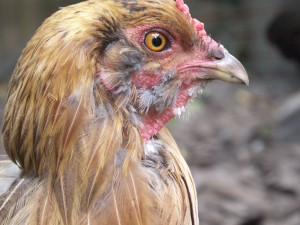
This has been a huge pain in the neck for both me and the hens and I hope I will get rid of the mites soon. Don’t worry about coming over, chicken mites don’t like humans. It’s just the thought of them that makes you itchy. And if someone wants to produce it with me, I think YouTube needs a video of how to dust a chicken.
Update: Since this post, I’ve learned that the mites do in fact bite humans. Many of my readers can vouch for that! And I did find YouTube videos for dusting a chicken. You can see some on my follow-up post here:
http://www.brooklynfeed.com/2011/05/dusting-your-chicken-for-mites/
Wash. prisoners plant seeds for conservation
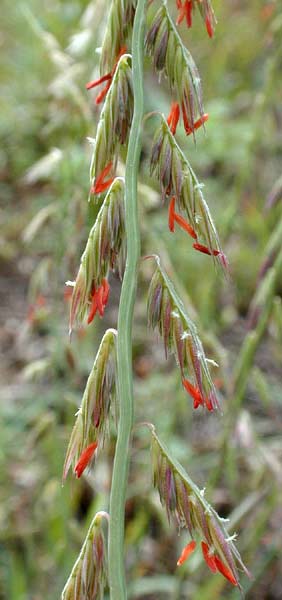
Sideoats Grama Prairie Grass
By CALLIE WHITE
OLYMPIA, Wash. — When the Nature Conservancy and The Evergreen State College needed a lot of labor for not a lot of money in order to help preserve a pristine piece of wetland, they ended up turning to Stafford Creek Prison, of all places.
It was quite a meeting, said Nalini Nadkarni, a professor at Evergreen.
“One of the things I see as a stereotype is that prisons are black holes for people, money, resources and effort,” Nadkarni said. Of course, as a scientist, she was used to being pegged with a stereotype herself, as the fuzzy-headed Ivory Tower academic pursuing arcane knowledge of little practical value.
Nadkarni’s pilot project has inmates cultivating endangered prairie grasses and so far, it’s been a success.
In a large greenhouse behind the prison’s campus, offenders plant individual seeds of showy fleabane in hundreds of yellow plastic tubes. Other species of grasses are already starting to grow in starter containers in the back of the greenhouse. Near where the prisoners work, a glassed-in beehive thrums with activity.
Volunteers collected the seeds by hand out in the field. Now, inmates are dusting them over lightly with soil.
“They’re so small,” inmate Toby Erhart said of the seeds, which he’s trying to put five to 10 of in each tube. Although the work is “tedious, at best,” he added that it’s a privilege to be outdoors.
Edward Turner, an inmate who says he was an organic farmer from Eastern Washington, said he was “from the old school hippies! In the days before it was popular.”
It was nothing new to Turner to plant seeds that would restore soils, but it was clear that it was a task he particularly enjoyed.
“This is real good for me,” Turner said. “We’re helping in some small way to make the planet a better place. It’s good to bring nature back.”
Once the grasses have sprouted and grown, they’ll be taken to Fort Lewis, where they’ll be planted in meadows that are used as artillery ranges.
“Artillery fields are the most pristine areas because nothing goes there,” said Rod Gilbert, a biologist at Ft. Lewis with the state Department of Fish and Wildlife. The only creatures that dare to enter are birds, insects and small animals such as frogs and Mazama pocket gophers, he said.
Once the grass patches are established, they can be used for seed collection, so another round of propagation can begin.
Although it is hard to think of grasses as endangered species, it’s a fact, Gilbert said.
“Native Americans used to burn off the meadows with fire once a year,” he said. That both helped the grasses propagate and repressed tree seedlings. But the practice stopped when settlers came to the Oregon Territory and took the land as their own, causing forest to encroach on the grasslands, he said.
This will be the first large-scale restoration project launched from a prison on the West Coast, Gilbert said.
“We’re totally psyched about it,” he added.
This is not the first partnership between the Corrections Department and the Nature Conservancy. Cedar Creek Corrections Center ran a program breeding endangered frogs. One of the offenders who worked on the project became part of the scientific team that published articles in scientific journals about their discoveries, Nadkarni said.
It’s exciting to see the critical thinking and observational skills of scientists develop in inmates, she added.
“For scientists like me, I think it’s important to talk to people beyond academia,” Nadkarni said. “We need to transmit our way of understanding the world.”
The project, which is funded by federal dollars, just couldn’t have been feasible outside of the prison, said Jeff Muse, Evergreen’s sustainable prisons project manager. It takes too much labor, which is extremely expensive on the outside. Offenders make about 45 cents an hour.
More than their wages, the prisoners not only learn the skills of cultivating plants, they learn they can use that skill outside of landscaping and gardening, Muse said.
“It’s green-collar education,” he said.
But Muse, like Nadkarni, sees the program in a much broader light. Making an institution compensate in some way for its use of environmental resources makes a much larger impact than just hoping everyone tries to cut down on creating trash and buys fluorescent lights. He likened institutions such as hospitals, prisons and schools to cargo ships, which don’t turn on a dime, but do gather steam as they head in a new direction.
Julie Vanneste, the Department of Correction’s sustainability coordinator, said Washington is a model state when it comes to sustainability, and Stafford Creek is its model prison for sustainability.
Muse pointed out that sustainability is often cast as a concern of yuppies. He shares Nadkarni’s misson to spread the scientific word to everyone. Global climate change and the rapid loss of species to overdevelopment will ultimately affect everyone, he said. As a scientist, however, he said he realizes the programs may sound great, but he’s hoping to back them up with studies to find out how effective they are.
“None of this will matter unless we figure out how it works or why it works,” Muse said.
Stafford Creek’s sustainability programs don’t start and end with field grasses. The prison composts its food waste and grows its own fruits and vegetables. It has a comprehensive recycling program. And it repurposes old bikes to give to charity.
Reusing and fixing old things isn’t just a skill for the prison, it’s a skill that can start a business. Muse brought Eli Reich, a former Seattle bike messenger who founded Alchemy Goods when he started selling bags made out of old inner tubes, to talk to the inmates about his business. Muse said offenders could do the same once they got out of prison.
“We want them to take what is useless and make it useful,” Muse said.
The same could be said, to a degree, about the inmates. Dan Pacholke, former Stafford Creek superintendent and current facilities administrator for Western Washington, said 97 percent of the state’s 16,000 offenders are headed for release someday, and they need to come out better than they went in. And doing science, which gets inmates to use critical thinking skills and creates a sense of social engagement, is one way to do that.
“I’d like to see science projects in every prison in the state,” Pacholke said.
Get Free Coffee Grounds from Starbucks

Here’s some information on using coffee grounds in your compost from Starbucks. Besides getting spent grounds from Starbucks, I’m sure any of your local coffee shops would be happy to hand some over. You can divert great organic matter from going to a landfill and improve your garden at the same time.
| Coffee grounds can provide a valuable source of nutrition for your garden. The proper amount to be used depends on the condition of your soil and what you are growing. Check with a local gardening expert or your local parks to see what is best for your garden. Here are a few general tips:Applying coffee grinds directly to your garden: Coffee grounds can be applied directly as a top dressing to acid loving plants like blueberries, hydrangeas, and azaleas (acid loving plants thrive in areas where rainfall is common in the warm season). Adding brown material such as leaves and dried grass to the mulch will help keep a balanced soil pH. Mixing coffee grounds in your compost: Using coffee grounds in your worm bin: What’s in Coffee Grounds? Primary Nutrients Nitrogen……….1.45% Phosphorus……ND ug/g Potassium…….1204 ug/g Secondary Nutrients Calcium……….389 ug/g Magnesium……448 ug/g Sulfur…………high ug/g ND = indicates sample is below detection limit ug/g = microgram/gram |
Gardening with a Purpose
from Detroit Lakes-Online, July 8, 2009
Increasing urban sprawl is creating more homes for people by taking away habitats for wildlife, forcing nature’s creatures to become vagabonds on the move or leaving them homeless on the streets.
In fact, according to The Biodiversity Project, a leading environmental advocacy group dedicated to conservation initiatives, one million acres of open space, including parks, farms and natural areas are lost to sprawl each year.
However, others are fighting to reverse this damage from development by providing food, water and shelter for evicted animals, transforming their own backyards into wildlife sanctuaries.
Detroit Lakes resident, Liz Ballard, lives in town not far from Highway 10. Entering her yard from the paved sidewalk one stets through an arch of native vines into a haven of ferns and wildflowers with birds chirping, bees buzzing and chipmunks running across the visitors’ feet.
Though Ballard said that she started her gardens when she moved into town for her own benefit as well — to use as an escape from the city.
“I’ve always been a country girl,” Ballard said. “I missed seeing the animals.”
National Wildlife Federation Ambassador for the Wildlife Habitat Program and sustainable garden landscaper, Mat Paulson, said that the trend of natural gardening is increasing in northern Minnesota as homeowners learn more about the many benefits.
Sustainable gardening attracts wildlife and also helps the environment reducing dependency on pesticides, improving air and soil quality and cutting down energy use on regular garden maintenance. Con
Paulson also said that natural gardening is beneficial for your pocketbook. As native plants and shrubs are already tolerant of Minnesota weather conditions, less care and cash needs to be placed towards watering and expensive fertilizers.
According to the National Wildlife Federation, attracting wildlife is a simple accomplishment:
• Food — This may include providing bushes with berries, flowers with nectar and pollen or supplemental bird, squirrel, and butterfly feeders.
• Water — There needs to be presence of standing water that wildlife can access for drinking and bathing. This can include seasonal pools, birdbaths, rain gardens or ponds.
• Cover — Wildlife need shelter from bad weather conditions and predators such as wooded areas, bramble patches, rock piles and roosting boxes.
• Places to raise young — Wildlife also requires special areas to bear young. Some examples include mature trees, dead trees, dense shrubs and nesting boxes.
Providing these habitat conditions will make your home a portal to the great outdoors. To learn more about sustainable gardening to attract wildlife, obtaining your backyard wildlife habitat certification and listen to Mat Paulson speak, attend the “Creating a Wild Backyard” workshop at Tamarac National Wildlife Refuge at 2 p.m. on July 12 at the visitors center.
My Urban Farm's Early Harvest
I have been enjoying the beginning harvest of my little city garden. We’ve had spinach and salad greens for weeks, but now we’re getting bush beans, blueberries, tiny carrots and nasturtiums. It seems that I really went for the multi-colored veggie seeds. Probably wanting color when I ordered the seeds in the middle of winter.
This is the first year that I grew beans and that’s been a big success. I have a lot of light, but it travels between buildings, so technically I’m partly sunny.
It’s been very cold and rainy, which has helped extend the season of the greens. It has wreaked havoc on my basil because we seem to have a bumper crop of baby slugs. So the basil looks like swiss cheese. I pinched it back and already the new leaves look much better. Plus we’ve been having sun, so that should help as well. If I need to I will either put out some beer to lure the slugs or sprinkle some diatomaceous earth around the plants. The DE is made of tiny diatoms, which nick the slimey surface of the slugs and causes them to die. I think I’ll start with the beer though (if I can wrestle it away from my husband). I think the DE might harm the earthworms, which I really don’t want.
I have loads of tomatoes, so it will be interesting to see how they do. So far they look beautiful. I can’t wait for real tasting tomatoes!!!
Gowanus Scavenger Hunt and BBQ
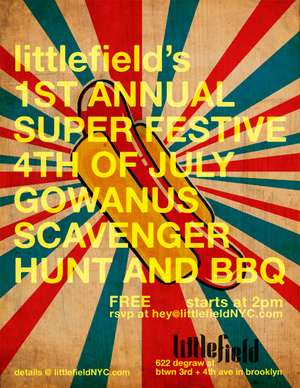
Littlefield is hosting its 1st annual Super Festive 4th of July Gowanus Scavenger Hunt and BBQ. They start the fun at 2pm (622 degraw, brooklyn, ny 718-855-3388) with bbq, djs, free booze and prizes. Your team (sign up at hey@littlefieldnyc.com) can earn 100 points if you are the first to drag out an old tire from the Gowanus Canal. Yikes. You might be glowing brighter than the fireworks after wading in the water!
Twilight Hour in Prospect Park
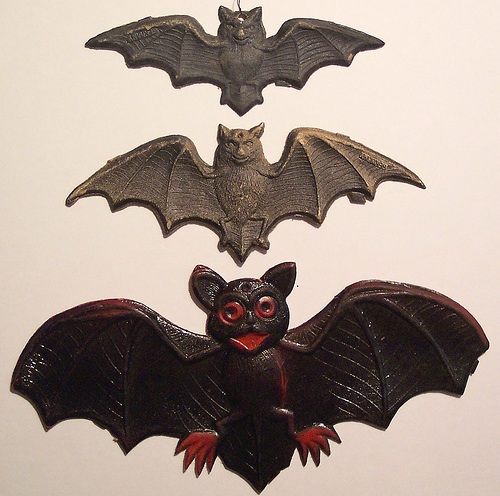 Tonight at the Audubon Center in Prospect Park in Brooklyn, there will be a Twilight Tour. Enjoy wine and cheese on the balcony of the boat house and then tour Lullwater on their boat Independence, which is a replica of a turn-of-the-20th century boat. After the ride, you will go on a bat walk with an Audubon naturalist.
Tonight at the Audubon Center in Prospect Park in Brooklyn, there will be a Twilight Tour. Enjoy wine and cheese on the balcony of the boat house and then tour Lullwater on their boat Independence, which is a replica of a turn-of-the-20th century boat. After the ride, you will go on a bat walk with an Audubon naturalist.
Call 718-287-3400 x 102 for reservations. $30 per person (cash only).
Selected summer Thursdays, 6:30 p.m.
If you miss the one tonight, there will be others on:
July 2, 9, 30,
August 6, 13, 20, 27
Earth Baby Compostable Diapers
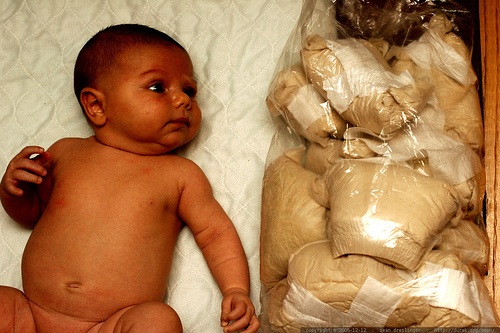
One Day of Diapers. Photo © Sean Dreilinger
Earth Baby was founded by three California Bay Area families who saw the amount of disposable diapers they were sending to the landfill and wanted to do something about it. They launched Earth Baby, which is a service that delivers diapers and wipes. They come later to collect the used diapers and bring them to a composting facility. The composting process uses only .5 watt-hour of electricity per diaper (equivalent of running a 60 watt light bulb for 30 seconds), no water or chlorine bleach.
The diapers themselves are made of natural unbleached FSC (Forest Stewardship Council) certified wood pulp and a super-absorbent gel. They are 100% chlorine and fragrance free. The composted diapers are turned into a high-quality top-soil, which is used at local golf courses and sod farms.
I am a sucker for the stats that show how many trees have been saved by using recycled paper towels for a year, or how much energy I’ve saved over a year with just one compact fluorescent bulb. If you are like me, you will like to know that as of June 26, 2009, Earth Baby has composted 29,220 pounds of diapers to date.
They currently only service the Bay area, but their business is growing rapidly, so hopefully they will be available in other cities soon.


